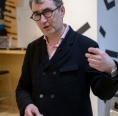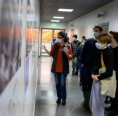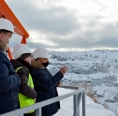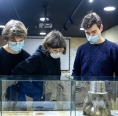-

SATKA AND GITIS EXPECT NEW PROJECTS
-
Address:
-
Partners:
Satka and GITIS, the largest Institute of Theatre Arts in Russia and Europe, expect new projects.
The Institute for the first time develops the practice of cooperation with a certain city and a region: as part of the working visit of its representatives to the Institute in Satka, which took place this week. GITIS, the Satka District Administration and "Sobranie" Fund entered into a three-party cooperation agreement. Commenting this a once-off experience, Grigory Zaslavskiy, rector of GITIS, theater historian, said:
“This all is for the first time. We have never entered into a cooperation agreement with a certain region. We work with universities, drama schools... But for the first time with a city. And we hold the Producer Laboratory in Satka for the first time. We’ve been longing to do this for a long time. And we got to implement this project here. Our cooperation began long before we entered into the agreement. We are absolutely sure that our first steps persuaded the city in our commitment and that our students, teachers, heads of the Institute are interested in activities in Satka. I mean that we checked each other, understood that we suit one another and today we signed the cooperation agreement. It seems right to me.”
In continuation of the conversation about joint projects and new plans, Grigory Anatolievich answered the questions of Magnezitovets Newspaper and Satka journalists.
“Grigory Anatolievich, as it is your first visit to Satka, tell us please how did you get to know it?”
“I saw a lot of wonderful books depicting Satka in all its beauty. Any facts of life differ from sugary photos in gift albums. But the industrial scale (edit: i.e. the Satka Magnezit Group production site) can’t be beaten up. I got the strongest impression when visiting the plant. This huge “pipe”, a furnace that spins, the modern workshop buildings, the robots, it’s amazing! Probably, the modern production should look like this. But I was glad to see it far enough from Moscow, Europe and industrial global centers. Lanterns in Proletarskiy avenue that change the city, it’s really fascinating. It’s all that I liked and maybe that I didn’t notice in the said albums.
On the one hand, there are amazing objects that have been preserved for years, like the Magnezit Cultural Center from the Soviet, Stalinist times. On the other hand, it’s a flexible, modern city that really doesn’t want its people to leave. The city that wants people to have reason to stay and think that here they can also live. It’s very important.”
“Industry and culture. How do you think they are integrated? Especially here in Satka, where culture and industry face each other in a line, that is the Magnezit Cultural Center and the Magnezit Plant?”
“The most important is that people managing industry understand that culture is an essential part of their lives and production. From industrial design, workshops decoration style to musicians and festivals held here, Satka has become a part of the Ural Industrial Biennale of Contemporary Art. Everything for the people to feel as part of the classical art. Unique projects with the Russian Museum took place when paintings were taken out of the museum space. That is impossible to believe in! As a person who ran exhibitions, I know what a museum piece given to the third party is. I know how everything is checked so that the paintings tour succeeds.
The manufacture itself becomes more modern, clear, the vacant space might become public, another area. Now “creative industry” is a modern phrase in Russia. And the city that parts with some of the industrial areas start thinking where people can employ and what can be done for it. It’s a modern approach inspiring respect. It’s also the case surprising you how someone can keep up with all modern ideas.”
“Is this the reason why GITIS comes to Satka?”
“Yes, of course. We want to follow trends.”
“Speaking about ideas and thoughts the group came to Satka with, did something turn on its ear after getting here?”
“I believe that such things occur only on the spot. As Dmitriy Olegovich Butkevich said, it’s “site-specific”. These are the projects that occur to you on site and are related to it like some comprehension of the spot.”
“Are you going to cooperate with local cultural workers?”
“We didn’t discuss certain projects but, for instance, I considered GITIS to manage the choreography studio. To set rotational shiftwork throughout the year, for example, when one young choreographer would come to teach for 3 months, another choreographer – for the next 3 months. And as a result, your students would get 4 different experiences, undergo 4 different training system. And in a year, there would be four different performance.”
-----------
Also, on February 3 in the Art-Satka creative public space, a creative meeting with the rector, teachers and students of the Kamenkovich-Krymov Workshop of the GITIS directing department was held. Representatives of the largest theater Institute of the country spoke about their class activities and demonstrated their projects.
Based on Magnezitovets. Photo by Vasily Maximov
-
26.08 - 26.08
DIARY OF THE THIRD INDUSTRIAL BIENNALE
-
28.11 - 28.11
MY SATKA FESTIVAL WINS THE CONTEST OF CORPORATE VOLUNTEER PROJECTS
-
13.10 - 15.10
COOPERATION WITH VGIBL NAMED AFTER M.I. RUDOMINO




